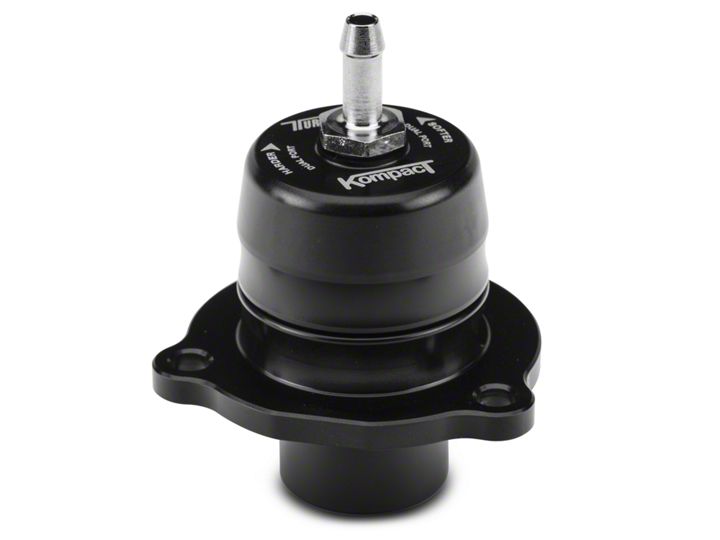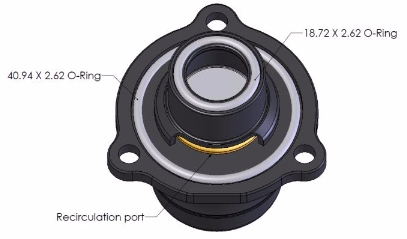
How to Install Turbosmart Kompact Shortie Dual Port BOV on your F-150

Shop Parts in this Guide


-RECOMMENDATIONS
• Turbosmart recommends that your Blow off valve (BOV) is fitted by an appropriately qualified technician
Turbosmart recommends that a boost gauge be permanently fitted to the vehicle
Locate the factory BOV on the compressor cover of the turbocharger. Undo the securing bolts and remove the standard bypass valve.
Remove the vacuum/boost line from the Factory BOV nipple.
Fit the Turbosmart Kompact Dual Port BOV onto the compressor cover of the turbo. Make sure that the supplied O-Rings are in their grooves on the BOV and that the orientation of the BOV is with the flat section of the BOV towards the intake of the turbocharger.
Use the supplied screws to secure the BOV onto the compressor cover.
Refit the vacuum line and secure with a clamp.
Start the engine and check for leaks. ADJUSTING YOUR BOV The aim of the adjustment on the Dual port is to make sure that the piston is hard closed at idle and that the piston closes fast enough to minimise backfiring and not stall the engine. In most cases, the cap is in the correct position from factory but with certain engine modifications, springs changes are required to tune the performance of the valve to the turbo system. Adjustment to the BOV is made by rotating the cap. To increase the spring force on the piston, rotate the cap clockwise in the direction of hard as marked on the top of the cap. To decrease the spring force on the piston, rotate the cap anticlockwise in the direction of soft as marked on the top of the cap - CAUTION - Do not rotate the cap beyond the O-Ring groove. Once it is confirmed that the piston is fully closed at idle, perform the following adjustment procedure.
Start with the BOV cap at the maximum soft position (The O-Ring should be completely covered by the edge of the cap)
With the engine at idle the exhaust port should be closed off by the piston – the piston should be hard against the seat and not floating or moving
Free rev the engine and back off quickly, the engine should return to normal idle speed – if the engine drops below idle or stalls increase the spring tension by one turn Repeat this process until the engine free revs and returns to normal idle speed
Test drive the car and ensure that when decelerating or changing gears that the engine has minimal backfiring and no stalling. If backfiring is excessive or stalling is noticed then check all connections made during the installation, otherwise increase the spring tension MAINTENANCE Turbosmart recommends that the following maintenance procedure is carried out at six monthly intervals or at higher intervals if the environment is very dusty or wet. Regular maintenance will ensure that your BOV is operating at its peak performance and will extend the working life of the product.
Remove the cap of the BOV by rotating in an anti-clockwise direction – CAUTION, the cap is under spring force, remove with care!
Carefully remove the piston and thoroughly clean the piston and the bore of the BOV Inspect the surface of the piston and the bore of the BOV for scoring or excessive wear, silver coloured marks on the bore are an indication of excessive wear
Check the Base O-ring and the Cap O-ring for any damage – replace if necessary
Lubricate the bore and the piston with Uni-Glide™, hydraulic oil or sewing machine oil – DO NOT use grease or viscous oils Re-assemble the BOV in the reverse order TROUBLE SHOOTING The following points should be checked if you find that your engine is dipping below normal idle, stalling or if the BOV is functioning poorly. Please note: the following checks will cure 99% of problems experienced with a BOV. - Check the vacuum hose for splits, cracks, loose connection, kinking or any obstruction – old or fatigued hose may collapse under vacuum causing an obstruction. - With the engine running remove the vacuum / boost hose from the nipple in the cap of the BOV, there should a loud hissing sound. The engine should idle poorly, double check by covering the end of the hose with your finger – otherwise the hose is blocked. - Check to see if the BOV is blocked or contaminated with dirt or debris. - Ensure that the vacuum / boost source is not shared and that the vacuum source is directly from the inlet manifold. - Check the seal between the compressor cover flange and the BOV. Make sure the supplied O-Rings are installed properly and the BOV Flange is secured on the compressor cover flange with the 3 supplied screws. - Ensure the spring clamps are secured on silicon hoses and fittings.

